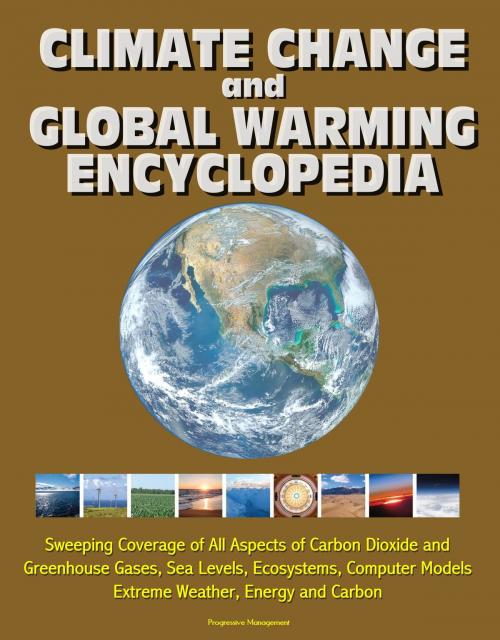Climate Change and Global Warming Encyclopedia: Sweeping Coverage of All Aspects of Carbon Dioxide and Greenhouse Gases, Sea Levels, Ecosystems, Computer Models, Extreme Weather, Energy and Carbon
Nonfiction, Science & Nature, Science, Biological Sciences, Ecology, Earth Sciences| Author: | Progressive Management | ISBN: | 9781301975815 |
| Publisher: | Progressive Management | Publication: | April 3, 2013 |
| Imprint: | Smashwords Edition | Language: | English |
| Author: | Progressive Management |
| ISBN: | 9781301975815 |
| Publisher: | Progressive Management |
| Publication: | April 3, 2013 |
| Imprint: | Smashwords Edition |
| Language: | English |
Investigate all aspects of climate change and global warming in this massive, authoritative compilation of up-to-date official documents from dozens of federal sources, with details about carbon dioxide, greenhouse gases, methane, rising sea levels, coastal threats, effects on plants, animals, birds, and other wildlife, potential damage to ecosystems, impacts on human health, the use of computer models to forecast future trends, the possible increase of extreme weather events, the role of energy sources in the carbon footprint, federal research and response efforts, satellite information, extensive glossaries, and much more.
There are fifteen parts: Part 1: NASA Material * Part 2: Environmental Protection Agency (EPA) Material * Part 3: National Oceanic and Atmospheric Administration (NOAA) Material * Part 4: Department of the Interior (DOI) Material * Part 5: U.S. Fish and Wildlife Service (FWS) Material * Part 6: Centers for Disease Control and Prevention (CDC) Material * Part 7: U.S. Department of Agriculture and Forest Service Material * Part 8: U.S. Army Corps of Engineers Material * Part 9: NASA Energy Innovations Material * Part 10: Glossary of Climate Change Terms * Part 11: Energy Efficiency Glossary * Part 12: Federal Actions for a Climate Resilient Nation: Progress Report of the Interagency Climate Change Adaptation Task Force * Part 13: U.S. Environmental Protection Agency Climate Change Adaptation Plan * Part 14: Our Changing Planet - The U.S. Global Change Research Program for Fiscal Year 2013 * Part 15: The National Global Change Research Plan 2012-2021 - A Strategic Plan for the U.S. Global Change Research Program
The Earth's climate has changed throughout history. Just in the last 650,000 years there have been seven cycles of glacial advance and retreat, with the abrupt end of the last ice age about 7,000 years ago marking the beginning of the modern climate era — and of human civilization. Most of these climate changes are attributed to very small variations in Earth’s orbit that change the amount of solar energy our planet receives. The current warming trend is of particular significance because most of it is very likely human-induced and proceeding at a rate that is unprecedented in the past 1,300 years. Earth-orbiting satellites and other technological advances have enabled scientists to see the big picture, collecting many different types of information about our planet and its climate on a global scale. Studying these climate data collected over many years reveal the signals of a changing climate. Certain facts about Earth's climate are not in dispute: The heat-trapping nature of carbon dioxide and other gases was demonstrated in the mid-19th century. Increased levels of greenhouse gases must cause the Earth to warm in response. Ice cores drawn from Greenland, Antarctica, and tropical mountain glaciers show that the Earth’s climate responds to changes in solar output, in the Earth’s orbit, and in greenhouse gas levels. They also show that in the past, large changes in climate have happened very quickly, geologically-speaking: in tens of years, not in millions or even thousands.
The consequences of changing the natural atmospheric greenhouse are difficult to predict, but certain effects seem likely: On average, Earth will become warmer. Some regions may welcome warmer temperatures, but others may not. Warmer conditions will probably lead to more evaporation and precipitation overall, but individual regions will vary, some becoming wetter and others dryer. A stronger greenhouse effect will warm the oceans and partially melt glaciers and other ice, increasing sea level. Ocean water also will expand if it warms, contributing further to sea level rise.
Investigate all aspects of climate change and global warming in this massive, authoritative compilation of up-to-date official documents from dozens of federal sources, with details about carbon dioxide, greenhouse gases, methane, rising sea levels, coastal threats, effects on plants, animals, birds, and other wildlife, potential damage to ecosystems, impacts on human health, the use of computer models to forecast future trends, the possible increase of extreme weather events, the role of energy sources in the carbon footprint, federal research and response efforts, satellite information, extensive glossaries, and much more.
There are fifteen parts: Part 1: NASA Material * Part 2: Environmental Protection Agency (EPA) Material * Part 3: National Oceanic and Atmospheric Administration (NOAA) Material * Part 4: Department of the Interior (DOI) Material * Part 5: U.S. Fish and Wildlife Service (FWS) Material * Part 6: Centers for Disease Control and Prevention (CDC) Material * Part 7: U.S. Department of Agriculture and Forest Service Material * Part 8: U.S. Army Corps of Engineers Material * Part 9: NASA Energy Innovations Material * Part 10: Glossary of Climate Change Terms * Part 11: Energy Efficiency Glossary * Part 12: Federal Actions for a Climate Resilient Nation: Progress Report of the Interagency Climate Change Adaptation Task Force * Part 13: U.S. Environmental Protection Agency Climate Change Adaptation Plan * Part 14: Our Changing Planet - The U.S. Global Change Research Program for Fiscal Year 2013 * Part 15: The National Global Change Research Plan 2012-2021 - A Strategic Plan for the U.S. Global Change Research Program
The Earth's climate has changed throughout history. Just in the last 650,000 years there have been seven cycles of glacial advance and retreat, with the abrupt end of the last ice age about 7,000 years ago marking the beginning of the modern climate era — and of human civilization. Most of these climate changes are attributed to very small variations in Earth’s orbit that change the amount of solar energy our planet receives. The current warming trend is of particular significance because most of it is very likely human-induced and proceeding at a rate that is unprecedented in the past 1,300 years. Earth-orbiting satellites and other technological advances have enabled scientists to see the big picture, collecting many different types of information about our planet and its climate on a global scale. Studying these climate data collected over many years reveal the signals of a changing climate. Certain facts about Earth's climate are not in dispute: The heat-trapping nature of carbon dioxide and other gases was demonstrated in the mid-19th century. Increased levels of greenhouse gases must cause the Earth to warm in response. Ice cores drawn from Greenland, Antarctica, and tropical mountain glaciers show that the Earth’s climate responds to changes in solar output, in the Earth’s orbit, and in greenhouse gas levels. They also show that in the past, large changes in climate have happened very quickly, geologically-speaking: in tens of years, not in millions or even thousands.
The consequences of changing the natural atmospheric greenhouse are difficult to predict, but certain effects seem likely: On average, Earth will become warmer. Some regions may welcome warmer temperatures, but others may not. Warmer conditions will probably lead to more evaporation and precipitation overall, but individual regions will vary, some becoming wetter and others dryer. A stronger greenhouse effect will warm the oceans and partially melt glaciers and other ice, increasing sea level. Ocean water also will expand if it warms, contributing further to sea level rise.















